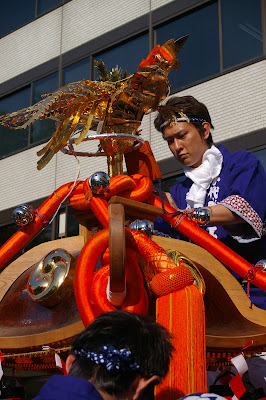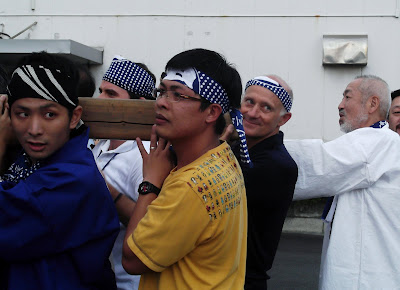A mikoshi is a portable Shinto shrine. Shinto followers believe that it serves as the vehicle of a divine spirit. Often, the mikoshi resembles a miniature building, with pillars, walls, a roof, a veranda and a railing. Typical shapes are rectangles, hexagons, and octagons. The body, which stands on two or four poles (for carrying), is usually lavishly decorated, and the roof might hold a carving of a phoenix.
Matsuri is the Japanese word for a festival or holiday. Festivals are often based around one or two main events, with food stalls, entertainment, and carnival games to keep people entertained. Japanese festivals are usually sponsored by a local shrine or temple, though they can be secular (in this case I'm not sure which) or in other instances around hanabi (fireworks). This year, many firework's festivals have been cancelled with the money going towards the Earthquake/ Tsunami victims. Instead of three in Yokohama there will only be one. There are no specific matsuri days for all of Japan but, festival days do tend to cluster around traditional holidays such as Setsubun or Obon (see end of post). Last year in Motomachi Street we even saw children carrying a miniature version of a mikoshi, as well as a taiko (the Japanese word for drum) drumming performance.
During a matsuri people bear a mikoshi on their shoulders by means of two or four poles. They bring the mikoshi from the shrine, carry it around the neighbourhood that worships at the shrine, and in many cases leave it in a designated area, resting on blocks, for a time before returning it to the shrine. Some shrines have the custom of dipping the mikoshi in the water of a nearby lake, river or ocean but this did not happen at the matsuri in Tsurumi. At certain festivals, the people who bear the mikoshi wave it wildly from side to side. At some point during the festival procession, the shrines are blessed by Shinto priests from the local shrine.
The mikoshi is often carried through the neighbourhood for hours on end. There's usually a team of 50 to 100 people, who work in shifts of 30 to 50 to carry the mikoshi, which can weigh several tons. As drums beat, the bearers chant 'Yassho! Yassho! all the way. After the festival, most participants have bruises on their shoulders but always claim that, despite the anguished expressions on their faces, they're having fun!
At the office where Steve is based there was a very large gathering of people. People from each of the Chiyoda Offices in Tsurumi, plus the expatriate companies working with the Japanese company excitedly assembled. Everyone, sporting blue and white headbands, watched as the mikoshi underwent final preparations. The ceremony began with the formalities, which included a sake kampaii and lots of chanting.
 |
| Yumi and Yuko enjoy a sake kampaii!! |
 |
| Shiraz is ready to share the load! |
Women were the first bearers and, at this stage, I tentatively joined in. Standing with friends, there was lots of giggling and excitement. With drums beating and people clapping and cheering we lifted the mikoshi onto our shoulders. For some reason, I'd imagined with so many people carrying it you wouldn't notice the weight (there were about 40 women bearers). Wrong!! It was heavy. I can attest to the bruises. At intervals, the ceremony leader would stop the procession so the bearers could lift the shrine up and down repeatedly to the beats of the drum. Naturally, we also had to stop for traffic lights during which time we couldn't put the mikoshi down! By the end of my shift, just over half an hour, my shoulder felt quite bruised and, after constantly chanting 'Yassho! Yassho!', my throat was a little dry. It was terrific fun though. Sugo-i sugo-i desu!
Steve joined the second shift of men and was also surprised at the weight (nothing a massage in Chinatown couldn't fix), particularly with the wild waving the men did. The shrine was finally returned to the office where it was left resting on blocks. The beer flowed freely and a feast followed. It was a fabulous experience but, possibly, not one I would do again. Another unique Japanese experience!!
Footnote:
Obon is a Japanese Buddhist custom to honor the deceased spirits of one's ancestors. This Buddhist custom has evolved into a family reunion holiday during which people return to ancestral family places and visit and clean their ancestors' graves. It is also when the spirits of ancestors are supposed to revisit the household altars. It has been celebrated in Japan for more than 500 years and traditionally includes a dance, known as Bon-Odori. The festival of Obon lasts for three days; however its starting date varies within different regions of Japan.
Shrines are set up in homes with food and drink placed on them for returning spirits to come and rest during Obon. In the evening of the last day waterways are illuminated by hundreds of floating paper lanterns that are cast off down the rivers to send the visiting spirits of ancestors back to the realms of the dead, sometimes you see the names of the deceased written on them.
Setsubun is a festival held one day before Spring in the Japanese lunar calendar but is not a national holiday. For centuries, the people of Japan have been performing rituals with the purpose of chasing away evil spirits at the start of spring. In the 13th century, it became a custom to drive away the evil spirits with the noise of drums and the smoke from burning sardine heads and wood. In modern days, a more common ritual is to throw roasted beans around the house and at temples and shrines. As you throw the beans you should shout...Oni wa soto! Fuku wa uchi! (Devils out, happiness in!). You then pick up and eat the number of beans which correspond to your age. Mmmm, that could take me a while!
















No comments:
Post a Comment